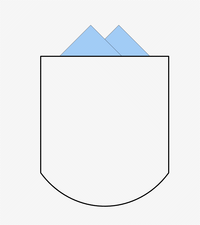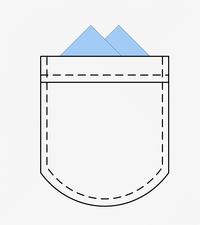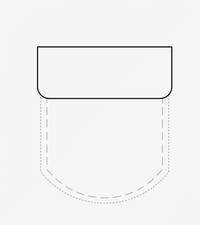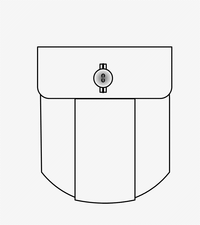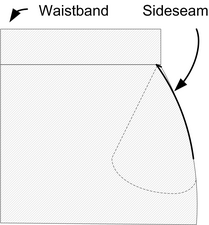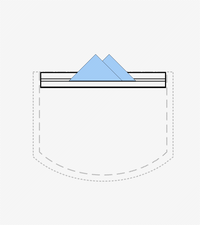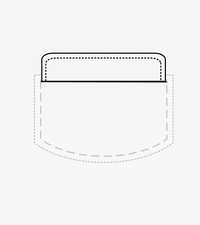
Apocketis abag- orenvelope-like receptacle either fastened to or inserted in an article ofclothingto hold small items. Pockets are also attached toluggage,backpacks,and similar items. In older usage, a pocket was a separate small bag or pouch.
Origins
[edit]
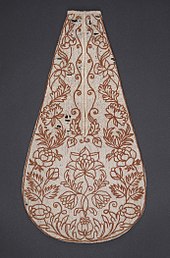
Ancient people used leather or cloth pouches to hold valuables.[1]Ötzi(also called the "Iceman" ), who lived around 3,300BCE,had a belt with a pouch sewn to it that contained a cache of useful items: a scraper, drill, flint flake, bone awl, and a driedtinder fungus.[2]
In European clothing, fitchets, resembling modern day pockets, appeared in the 13th century. Vertical slits were cut in the super tunic, which did not have any side openings, to allow access to purse or keys slung from the girdle of the tunic.[3]According to historian Rebecca Unsworth, it was in the late 15th century that pockets became more noticeable.[4]During the 16th century, pockets increased in popularity and prevalence.[4]
In slightly later European clothing, pockets began by being hung likepursesfrom a belt, which could be concealed beneath acoatorjerkinto discouragepickpocketingand reached through a slit in the outer garment.
In the 17th century, pockets began to be sewn into men's clothing, but not women's, which continued to be tied on and hidden under the large skirts popular at the time.[5][6]
The word appears inMiddle Englishaspocket,and is taken from aNormandiminutive ofOld Frenchpoke,pouque,modernpoche,cf.pouch.The form "poke" is now only used in dialect, or in such proverbial sayings as "a pig in a poke".
Historically, the term "pocket" referred to a pouch worn around the waist by women in the 17th to 19th centuries, mentioned in the rhymeLucy Locket.[7]In these pockets, women would carry items needed in their daily lives, such as scissors, pins and needles, and keys.[8]: 113
In more modern clothing, while men's clothes generally have pockets,those designed to be worn by womenoften do not - and sometimes have what are called Potemkin pockets (fromPotemkin village), a fake slit sewn shut. If there are pockets they are often much smaller than in men's clothes. Journalists atthe Puddingfound less than half of women’s front pockets could fit a thin wallet, let alone a phone and keys.[9]
Types
[edit]A watch pocket or fob pocket is a small pocket designed to hold apocket watch,sometimes found in men'strousersandwaistcoatsand in traditionalblue jeans.[10]However, due to the decline in popularity of pocket watches, these pockets are rarely used for their original intended purpose.
A besom pocket or slit pocket is a pocket cut into a garment instead of being sewn on. These pockets often have reinforcedpipingalong the slit of the pocket, appearing perhaps as an extra piece of fabric or stitching. Besom pockets are found on atuxedo jacketortrousersand may be accented with a flap or button closure.
Camp pockets or cargo pockets are pockets which have been sewn to the outside of the garment. They are usually squared off and are characterized by seaming.[11][12]
A beer pocket is a small pocket within a jacket or vest sized specifically for transporting a bottle ofbeer.It came into fashion in the 1910s in select areas of theAmerican midwest,prior toProhibition,after which it faded into relative obscurity before experiencing minor revivals in the 1980s and early 2000s.
Examples of pocket designs
[edit]In some of the following illustrations, a folded blue handkerchief is included for illustration purposes:
-
Patch pocket withpocket square
-
Patch pocket with topstitching
-
J patch pocket
-
Flap pocket
-
Buttoned-flap patch pocket with boxpleat
-
Sideseam pocket
-
"Smile" slit pocket withpipingand arrowhead reinforcements, typical ofWestern wear
-
Double-jetted pocket
-
Stand or single-welt pocket
-
Slant-front pockets
-
Watch pocket on right front pocket
-
18th century-style hanging pockets
-
Parts of a tailored pocket
See also
[edit]References
[edit]- ^"A History of Handbags".Random History.RetrievedApril 23,2016.
- ^"The Belt and Pouch".South Tyrol Museum of Archaeology. Archived fromthe originalon March 11, 2009.RetrievedApril 23,2016.
- ^Cunnington, C. Willett;Cunnington, Phillis(1969).Handbook of English Medieval Costume.Plays Inc.
- ^abUnsworth, Rebecca (2017-09-01)."Hands Deep in History: Pockets in Men and Women's Dress in Western Europe, c. 1480–1630".Costume.51(2): 148–170.doi:10.3366/cost.2017.0022.ISSN0590-8876.
- ^"The Sexist, Political History of Pockets".Racked.Retrieved15 March2018.
- ^Victoria and Albert Museum, Online Museum (2012-09-17)."Wearing Pockets".vam.ac.uk.Retrieved2021-01-25.
- ^"Historic New England: Defining the Past. Shaping the Future".Spnea.org. Archived fromthe originalon 2001-06-29.Retrieved2009-08-20.
- ^Weissman, Judith Reiter. (1994).Labors of love: America's textiles and needlework, 1650-1930.Lavitt, Wendy. New York: Wings Books.ISBN0-517-10136-X.OCLC29315818.
- ^"Women are big losers in the politics of pockets".Financial Times. 6 November 2022.Retrieved10 November2022.
- ^Levi Strauss & Co. Unzipped Team (17 April 2014)."Those Oft-Forgotten Pant Parts".Retrieved2015-11-03.
- ^"What is" Camp Pockets "- Definition & Explanation".RetrievedDecember 1,2011.
- ^"Glossary of fashion design terminology at Dress King".RetrievedDecember 1,2011.
Further reading
[edit]- Picken, Mary Brooks(1957).The Fashion Dictionary.Funk and Wagnalls.
- Carlson, Hannah (2023).Pockets: An Intimate History of How We Keep Things Close.New York: Algonquin Books.ISBN1643751549.
- "Pockets".Fashion & Jewellery Features.Victoria and Albert Museum.Archived fromthe originalon 2007-10-27.Retrieved2009-11-17.
- Different Types of Pocket

